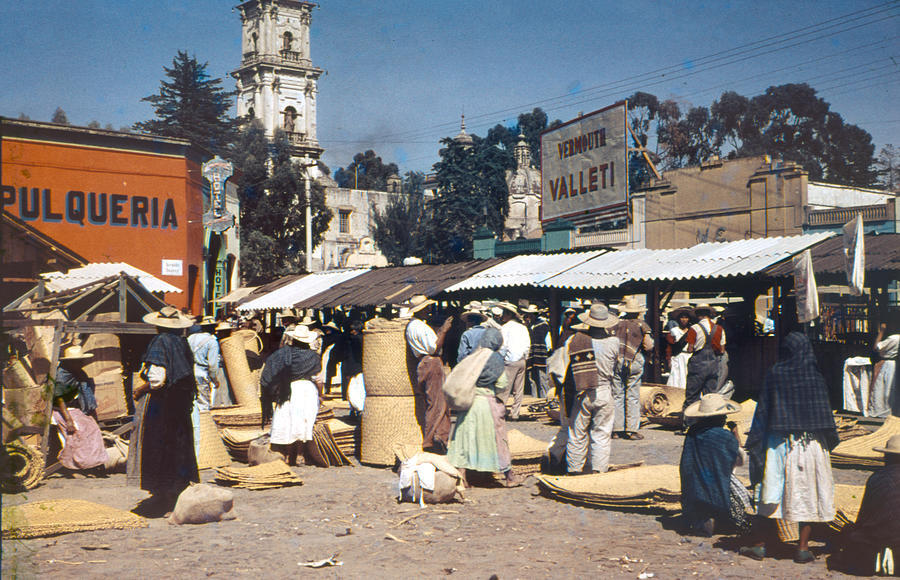
Toluca Market
*
On weekends, Langston took trips to Mexico City, where he attended the bullfights. In The Big Sea, he describes the belles of Mexico City, in their lace mantillas, "driving about the arena in open carriages preceding the fight" and Sánchez Mejías, a famous Spanish matador, who sent cold chills down Langston's back with "the daring and beauty of his veronicas."
Like so many foreigners who have tried to convey the allure of a bullfight, Hughes admitted that he "could never quite capture it on paper … like trying to describe the ballet." Nevertheless, in his autobiography, he presents a wonderful series of prose snapshots of a bullfight, the sights, sounds and smells of the corrida: "[They] must be seen in all their strength of vigorous and graceful movement and glitter of sun on sleek hides and silken suits spangled with gold and silver and on the sharp points of the banderillas and on the thin blades of the swords. Bullfights must be heard, the music barbaric and Moorish, the roar of the crowd, the grunt of the bull, the cry of the gored horse, the trumpet signalling to kill, the silence when a man is gored. They must be smelt, dust and tobacco and animals and leather, sweat and blood and the scent of death."
Although he wrote no other poems on Mexican themes, the young Hughes did publish a few prose pieces about Mexico in The Brownies Book, a magazine for African American children founded by W. E. B. DuBois, and The Crisis, another DuBois journal. "Mexican Games," his first essay ever to appear in an American magazine, was published in January 1921, a month before his nineteenth birthday. The essay is little more than a set of instructions on how to play "three games which children play in [the] beautiful neighbor country, Mexico."
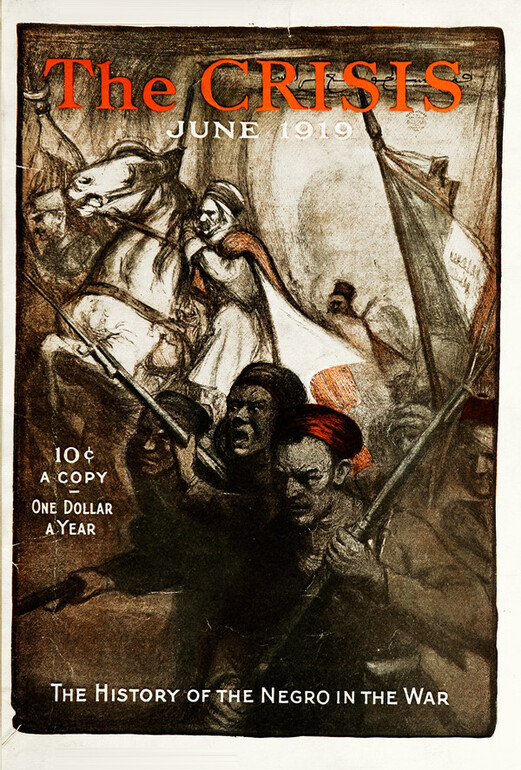
Hughes's descriptive talents came far more fully alive in another essay, "In a Mexican City," a four-page piece on Toluca. He described the climate, the local people, the park, the Catholic holidays, and the many churches with their "beautiful domes and tall, graceful towers."
"The houses," he wrote, "often have lovely court-yards and verandas but these are hidden from the passers-by behind high walls, and the fronts of the houses never tell anything about the beauty that may be within them. In the patio or court-yard there are flowers the year round and if it is a large one, there may be a garden or trees. On the railing of the long veranda, too, there are many pots of red and pink geraniums and fragrant heliotrope." Hughes goes on to tell his young readers about the sparsely furnished homes and the kitchens with their brick stoves fueled by charcoal. "Some are prettily built and covered with gaily colored tiles."
He liked Toluca's little shops, called expendios, where he could buy "a penny's worth of wood or a tablespoon of lard or a lamp full of oil." And he liked how these shops were painted in all sorts of colors and sported picturesque names. "One I know is called ‘The Wedding Banquet.' Others are ‘The Light of America,' ‘The Big Fight,' ‘The Fox,' and so on, and one tinner's shop is even called ‘Heart of Jesus.' One who did not know Spanish could acquire a whole vocabulary just by reading the store names which are painted in large colored letters across the front and are often accompanied by pictures or decorations to illustrate their meanings."
Half the essay is devoted to a description of Toluca's Friday market. "The square outside the market-house is one sea of wide Mexican hats, as buyer and trader jostle and bargain. The surrounding streets are lined with Indians from the country who squat behind their little piles of vegetables, or fruit, or herbs, which they have to sell and which they spread out on the ground before them." Anyone who has shopped at one of the open-air markets in San Miguel will recognize that things haven't changed much in the more than one hundred years since Hughes described the piles of peppers, beans, and "all sorts of strange, delicious fruits … creamy alligator pears and queer-tasting mangoes; red pomegranates and black zapotes; small, round melons and fat little bananas."
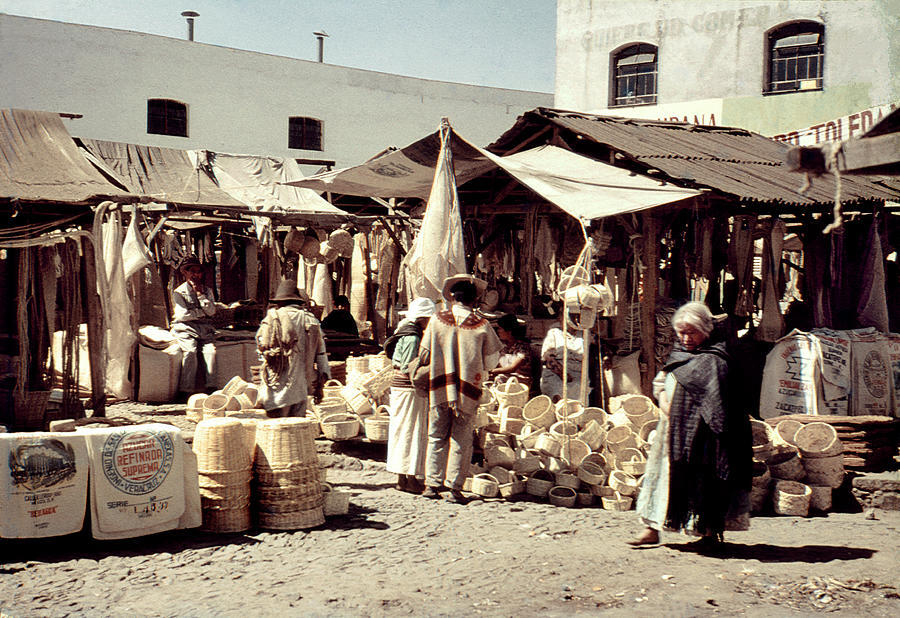
Toluca Market
*
Hughes wrote that people never went to the market without bargaining. "The price arguments are always good-natured." He added that everyone going to the market carried their own baskets and sacks "and even the paper for his meat, as everything is sold without wrapping." He loved the diversity of the market-day crowd, pushing and elbowing their way along: the "rich señorita with her black scarf draped gracefully about her shoulders" followed by the servants carrying baskets; the Indian women with sacks of vegetables on their backs; others with turkeys or chickens in their arms; the "little ragged brown boys seeking a chance to earn a few cents by carrying a customer's basket; and the beggars, blind, lame and sick, "all asking patiently for pennies or half-rotted fruits."
At the market, people carried everything on their heads: "The ice-cream man crying nieve, balances his freezer, and the baker-boys carrying a shallow basket as big around as a wagon wheel. The basket has a crown in the center and when filled with bread it fits over the head like a very wide Mexican hat, while its wearer underneath is as insignificant as the stem of a mushroom."
Hughes's third Brownies Book piece, "Up to the Crater of an Old Volcano," recounts an outing he made with a group of Toluca's high school boys to the crater of Xinantecatl. As they prepared for the hike, the boys advised Langston to pack plenty of water and lunch, warm blankets, a camera, cognac, and a pistol, because they might meet bandits along the way. "But above all," they told him, "take onions!" Onions, the boys said, were "the very best things to smell if one began to feel ill in the thin air near the summit."

They rode in a train out to the volcano. At Calimaya, they hired three burros to haul their stuff and guides to take them up to the summit. As the hike proceeded, they passed fields fenced in with cactus and maguey, where "slow-moving oxen were pulling wooden plows" and "wide-hatted peons pricked them languidly with sharp-pointed sticks." Leaving the foothills behind, they started up the slope of the volcano itself, eventually pitching camp at sunset.
The next morning, the group took off for the volcano. The steepness of the slope and the lightness of the air made the ascent difficult. "We had to cross the snow-covered spaces on our hands and knees—they were so slippery." But when they reached the summit, they were glad to look down into that part of the volcano where a lake, La Laguna Chica, sparkled in the sun. After breakfast, they continued on to the big lake, La Laguna Grande—"so beautiful and lovely and calm that it gave one a thrill of surprise at finding it buried in this old volcano's burnt, scarred walls." At one end of the shore, "a band of religious people" had erected a large wooden cross, and Hughes reported that masses were said here.
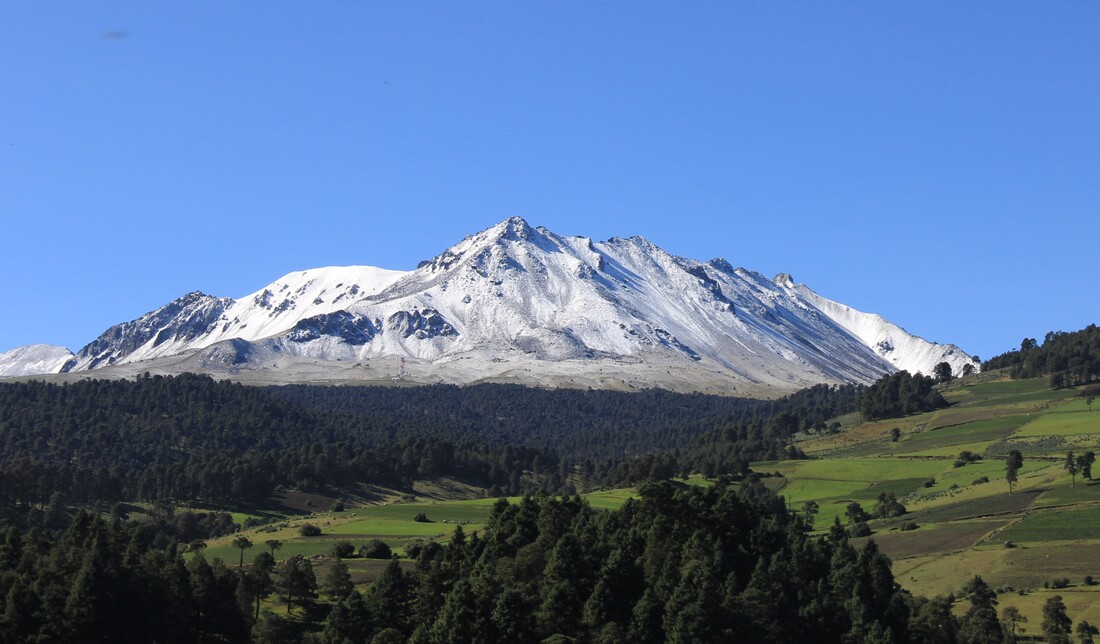
Xinantecatl
*
When they returned to Calimaya, Hughes looked back at the sharp, jagged peaks of the volcano. "They seemed so very high and so very far from us we could scarcely believe that just ten hours before we had visited them and drunk the cool snow water of their clear blue lakes."
After a year in Mexico, with financial help from his father, Langston sailed to New York to study at Columbia. His first night in the city, he stayed in a hotel in Times Square with two Mexicans he had met on the boat. "But where are all the poor people?" one of them remarked. "Caramba! Everyone is dressed up here." The other one kept asking, "Where is the grass? Where will I keep my chickens? Puta madre! Is there no grass?"
Hughes didn't like Columbia. The buildings "looked like factories," the students were standoffish, and he didn't take to his courses. He finished the year with honors, but withdrew from college, and moved to Harlem to begin life on his own. He was twenty.

Langston Hughes (early photo)
*
When his father died in 1934, Hughes returned to Mexico to settle the estate. He stayed until the spring of 1935. It was, he later recalled, "a delightful winter" despite the fact that he missed seeing and living with "Negroes in large numbers." He took a small apartment in Mexico City, where he lived la vie de bohème, socializing with poets, photographers, and painters, reading books in Spanish, and translating into English several poems and short stories by Mexican leftist writers. In his second autobiography, I Wonder as I Wander, he recalled, "We would often seek out the little bars and clubs where the mariachis played their guitars and wailed their corridos and huapangos." When word got out that Hughes, now a famous poet, was back in Mexico, he became even more popular within Mexico's artistic community, which led to essays being written about him and even more of his work being translated into Spanish.
"Hughes … wished to be understood clearly by his readers," writes Arnold Rampersad, in the preface to the 16-volume edition of Hughes's Collected Works. "On the whole, he had little time for, or patience with, those modernist poetic devices and approaches that tend to intimidate and alienate readers. In many ways, simplicity was the essence of his aesthetic. However, the sensitive reader soon discovers that in Hughes's art, as in so much of life, simplicity can be a complex affair."
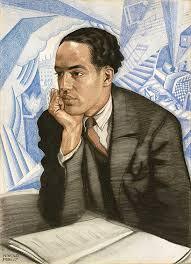
Langston Hughes (National Portrait Gallery)
*
One wishes that Hughes had written more poems and other pieces about Mexico, a country he deeply loved. Nevertheless, the Mexican sections in his two autobiographies and the little essays he published in The Brownies Book make for delightful reading for anyone who enjoys accounts of life in early twentieth-century Mexico.
**************
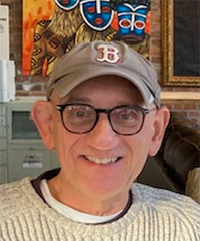
Philip Gambone, a retired high school English teacher, also taught creative and expository writing at Harvard for twenty-eight years. He is the author of five books, most recently As Far As I Can Tell: Finding My Father in World War II, which was named one of the Best Books of 2020 by the Boston Globe. His new collection of short stories, Zigzag, will be published in October.
**************
*****
Please contribute to Lokkal,
SMA's online collective:
 ***
***
Discover Lokkal:
Watch the two-minute video below.
Then, just below that, scroll down SMA's Community Wall.
Mission

Visit SMA's Social Network
Contact / Contactar

